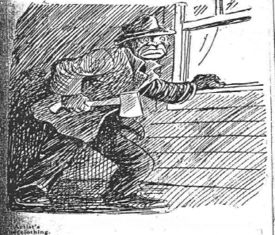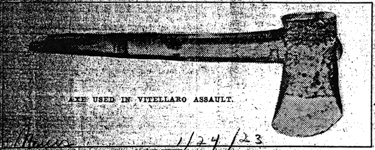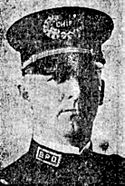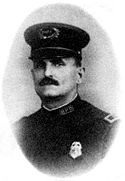Axe syndicate
The so-called axe syndicate was a group of people believed to have been responsible for a four-year spate of brutal killings which started in November 1919 and ended in May 1924.
Though no overall pattern connecting the crimes was established, they appeared to Birmingham Police Chief Fred McDuff to fall into at least two classifications. In many cases small shop owners, often foreign-born, were targeted in robberies, some of which were suspected of resulting from disputes between thieves and their fences. In another group of cases, police suspected retribution on behalf of presumed victims of miscegenation. From the few descriptions given by surviving victims, police considered all African Americans with criminal records to be suspects. The media helped shape the idea that a single killer, dubbed "Henry the Hacker" was to blame for the spate of gruesome murders.
Numerous arrests were made, and some convictions obtained in the attacks. Nevertheless, a public uproar rose in response to the frequent grisly attacks. Commissioner of Public Safety William Cloe made an "appeal to the people of Birmingham not to give way to hysteria over the recent axe murders," and continued denying the surge of pistol permits flooding his office. He did suggest that small merchants should consider closing earlier in the evenings. Sheriff Thomas Shirley also downplayed the story.
Though the evidence was thin and many victims refused to cooperate with police, investigators came to suspect a close group, or "syndicate" of killers. The Ku Klux Klan marched through Avondale in a show of force that McDuff hoped might stop the killings. An Italian Protection League also formed to defend shop-owners and their families. The attacks on shop owners apparently came to an end after five African Americans were arrested in the winter of 1923-24. At least the brutal armed robberies occurring after the arrests were no longer tied to "Harry the Hacker" or the "axe syndicate".
Accounts of the number of crimes committed by the gang vary, as do the lists of people killed or wounded in their attacks. The New York Times reported there had been 24 killed in 44 attacks, while the Birmingham papers counted only 15 dead and 13 wounded attributable to the "syndicate". A review of cases by Jeremy Gray for al.com in 2013 found 18 dead and 16 injured.
Four more arrests followed on January 6, 1924: Peyton Johnson, John Reed, and O'Delle and Pearl Jackson. According to one account, police were led to a house where the group bragged to each other about their murderous deeds on a tip from a paid informant.
During interrogations, the Jacksons, Johnson and Glover were given doses of an experimental "truth serum" consisting of scopolomine and morphine. While under the influence of the drug mixture, they collectively confessed to eight of the murders. Those confessions were affirmed after the effects of the drug had worn off. Furthermore, Jefferson County Solicitor James Davis said that the suspects' statements included elements of some of the crimes which had not been made public.
Investigators, which included Jefferson County Sheriff Thomas Shirley and Paul Cole, Chief of Detectives in the Birmingham Police Department, came to describe a "syndicate" of murderers who drew straws for the privilege of attacking selected targets. A man named Garfield was alleged to have founded the syndicate, but had died of natural causes during 1922. Three members of the gang were presumed to remain at-large. By February, 10 suspects had been identified.
Interrogations
Glover and the group of people suspected of being leaders in the syndicate caught in 1924 were interrogated using an experimental "truth serum", a mixture of scopolamine and morphine, which was also given to pregnant women to ease delivery. The drug put the suspects into what was described as a "twilight sleep," during which they lacked the will to lie.
The interrogations were led by a local physician, given the fictitious name of "A. A. Goldberg" in press accounts. He prescribed a typical dosage of four ounces of the mixture. After a preliminary medical examination to screen for conditions that would make the drug dangerous, the drug would be delivered in increments by hypodermic needle or in capsule form. The subject would be told beforehand to remember a number, and asked to recall it periodically while the drug was administered. When the subject could no longer remember the number, he was considered to be ready for questioning. Interrogation was conducted in a darkened room, using bright lights to "recall the suspect to his senses". The usual methods of the "third degree", such as pushing, rough handling, slaps, kicks, curses, terrifying stage effects, and deprivation from food, drink, and sleep, would not be used. The drug was not found to be infallible, as many statements made by prisoners were deemed meaningless.
In February 1924, Davis reported that he was convinced of the effectiveness of the serum. He credited it with leading police to parties they did not initially suspect, but whose involvement was corroborated by the discovery of physical evidence in searches. He stated that "when criminals adopt an attitude of silence in the Jefferson County jail their tongues will be unlocked with this serum," which he predicted would become "generally used" over the next few years. He indicated that police from around the country had contacted him for more information about the use of scopolamine in criminal investigation.
On the other hand, Davis recognized that judges and juries remained skeptical. He did not use testimony obtained from witnesses or suspects while under the influence of the drug in his prosecution of cases. He told the press in a statement that "evidence obtained while under drug will not hold in court, unless corroborated by other evidence."
Incidents
1919
- November 28: G. T. Airy or "Ary" was robbed at the Hill's grocery he managed at 24th Street and 10th Alley North . The cash drawer was emptied of $35. Airy was struck in the head and died later at the South Highlands Infirmary.
- December 24: John Besler was found bound, gagged and beaten to death with a shovel after a robbery at his mercantile shop at 1801 5th Avenue North.
1921
- March 5: C. C. Pipkins was struck by an ax at his store at 500 Walker Street in West End. He could not describe his attackers, but two customers who chased them off said that they were black males.
- March 5: J. J. Whittle was struck by an ax in a robbery at his shop at 8th Avenue North and Weaver Street. He was hit when he bent down to fill his attacker's request for an onion, but survived.
- July 13: Charles and Mary Baldone and their daughter, Virginia were wounded in an attack on their shop at 4510 10th Avenue North. The Baldones refused to aid in the police investigation, which concluded that the motive was a family vendetta. 3-year-old Frank Baldone survived, and remembered a black man attacking his father. Descendent Butch Baldone suspected that "The Black Hand", a national extortion ring that victimized immigrants, was responsible.
- July 17: H. L. Dorsky survived an attack at his shop at 719 16th Street North.
- August: Sophia Zipin (or Zapin) was wounded by a pair of robbers at her shop at 16th Street and 11th Avenue North. One suspect, Brooks, was identified early on. She also identified Fred Glover after he was arrested in 1922 for an attack on Tony and Rosa Lorino.
- September 6: Mrs Sam Zideman was wounded at her shop at 1700 9th Avenue North and 17th Street when she refused to hand over $60 in the register. She also refused to identify any suspects for police, but two black males were seen entering shortly before the robbery.
- October: Gaspera Lonzo was attacked at his shop at 2201 26th Street North. Mack Brown and Sylvester Brown were charged. Mack Brown was captured in Knoxville, Tennessee. He pleaded guilty and was sentenced to 15 years' labor in a prison mine on February 25, 1922. Sylvester Brown tried in Harrington Heflin's courtroom in March 1922. He was convicted and sentenced to 10 years.
- December 21: Joseph Mantione, 32 and his wife, Susie, 20, were robbed and killed at their store on 32nd Avenue North and Church Street. The murderers set fire to the store to cover up the crime. Thomas Price ran into the burning building and rescued their 10-month-old son, Pete. The weapon, an ax, was found under the stove at the scene. Three suspects were indicted by a Grand Jury in January 1922. Lillie Byrd, who owed money to the Mantiones, was convicted of both murders, tried in April 1922, and sentenced to two 99-year terms.
- December 21: Mose Parker was found dead and stripped of his hat and shoes in his back yard in Titusville. A suspect was arrested, but witnesses refused to appear.
1922

- January 11: Clem Crawford and his wife were robbed and killed at their home and shop at 1501 Avenue D. They were closing the store when attackers burst in, hitting them both with a hammer or axe. Mrs Crawford's throat was cut from eat to ear. She was buried while her husband remained unconscious. Several bloody fingerprints were found in the ransacked rooms. Several suspects were apprehended, and some released because their fingers did not match the prints found. Their three-year-old daughter, Josephine, was unharmed.
- January 25: Tony and Rosa Lorino were attacked and robbed at their shop just a few blocks away from Crawford's at 337 12th Street South. A man had come in and asked for some meal. When Lorino bent down to scoop some from a barrel, he was struck in the head. The attacker then rushed to the back of the store, where Rosa stood with their 11-month-old child. Mr Lorino managed to retrieve two guns, which he used to chase off the attackers. Eight suspects were arrested in the days following and shown to Lorino for identification. Six were later released. Den Penick, identified by a facial scar, was captured after a 10-day manhunt with help from the Cartwright Detective Agency, who intercepted a letter to his sister. Will Hewston and Hundley Price were also arrested. Another detainee, found with a bloody axe, was released when it was determined that he was a "half-wit" who had cut his own hand while making washboards. Thomas Lee Gardner and Nute Avery were held on $5,000 bond. Gardner was indicted, but Avery was acquitted by the Grand Jury. Lorino testified at trial in William Fort's courtroom, with the help of an interpreter. The jury convicted Gardner and sentenced him to life.
- March 7: Mrs S. N. Pharo was struck unconscious by an assailant armed with a short club or nightstick at her store at 4032 2nd Avenue North. The store was robbed of the $13 in the cash drawer. A suspect was arrested shortly afterwards and held until she recovered to make an identification.
- June 3: Joe and Lena Lucia were attacked at their store at 2005 Jasper Road. They survived.
- September 30: J. H. Seay, 60, was attacked and robbed at his grocery store at 39th Street and 35th Avenue North. He suffered a long gash from forehead to ear and was unable to remember what happened when questioned by police.
- October 21: Telegrapher Julius Silverburg, 20 and Louise Carter, a black woman, were murdered by blows to the head in an alley behind a home at 1816 6th Avenue North. Police first suspected "a Negro organization" avenging the "intermingling of the races," but later tied the attack to the string of ax murders of merchants.
- November 6: Abraham Levine and Sarah were attacked outside their store at 1600 Avenue D. The couple was lured from the store to show a house they rented to a prospective tenant, leaving their 16-year-old daughter, Emma to mind the shop. The suspect returned to the store, apparently to complete the robbery, but left after buying eggs after another customer came in. Emma and her uncle found her wounded parents behind the store. Abraham died two days later while Sarah recovered. John Harris and Spencer Clements were indicted for the crimes and tried in January 1923.
1923
- January 6: Robert John Turner, a painter, was killed at the home of an African American woman, Lillie Belle, who was knocked senseless, but survived the assault. Mary Francis Sanders testified that she was part of a group which had targeted the mixed-race couple. According to her account, the group of 10 were drinking "skulls and crossbones" in a downtown shanty when someone suggested they go "skulling" (knocking people over the head to rob them). She identified Peyton "Foots" Johnson and Odell and Pearl Jackson as having later bragged about Turner's murder. Pearl reportedly confessed a second time and was to have pleaded guilty, but denied the confession later. The three were convicted and sentenced to hang.
- January 10: Joe Kline and his daughter, Ethel, were attacked at their home at 1406 8th Avenue North during a robbery. Mr Kline died from his injuries. Ethel recovered, but was unable to identify the assailants.
- January 24: Luigi and Josephine Vitellaro were robbed and killed at their store, Vitellaro Grocery & Meats, at 2431 8th Avenue North. The cash drawer was emptied; their rooms ransacked. An axe with a shortened handle was found at the scene. Vitellaro, who regained consciousness for some time before eventually succumbing to his wounds, refused to help police, even when Italian-speaking Deputy J. V. Lauro was brought in to interview him. A white suspect was apprehended, but not enough evidence was obtained to prosecute. 19-year-old Pearl Jackson jailed along with her husband for Turner's murder, confessed to the crime.
- January 25: Costis Terlikis was attacked by a Black man who came into his store at 112 8th Avenue South. He recovered from his wounds.
- May 29: Calogero "Charley" Graffeo was robbed and killed in his store at 1500 7th Avenue North. It appeared as if the attacker had come in and placed a nickel on the counter to purchase a bottle of oil. Graffeo, a widower, was found behind the counter with his skull crushed by the blow of an axe and his throat cut. A blood-spattered axe with a shortened handle was found behind the shop's door. His pockets and the store's register had been rifled. Police speculated that his killer had tried to blackmail Graffeo over alleged bootlegging. Graffeo was buried at Fraternal Cemetery in Pratt City.
- October 9: J. H. Chaney of 1500 14th Avenue North was injured in an ax attack and recovered after a lengthy hospitalization.
- October 22: Elizabeth Romeo, 66, and Juliet Vigilant, were robbed and killed at Barnard Vigilant's shop at 210 21st Street South. The attacker used a meat cleaver and stole $60 from the cash register. Mr Vigilant returned home from a play to find his wife and Mrs Romeo battered in their beds. His 3-year-old daughter, Caroline, was left unharmed. Mrs Romeo died without regaining consciousness. Mrs Vigilant was able to describe their attacker as a "tall, slender negro" before she died a few days later.
- November 4: W. T. Conway, a white man, and Jane Jackson, a young African American, were attacked in a downtown alley with an axe or hatchet. Police theorized at the time that a "negro secret society" was acting violently "to prevent intimate relations of colored women with white men."
- November 25: John Juliana, a coal miner, was struck in the head and robbed while walking along a dark street.
- December 9: Edwin Sparks and his wife were attacked by a man while walking through a vacant lot. The attacker struck both of them in the head with a gun and ordered Mrs Sparks to "kiss him", threatening her if she refused. She screamed and was able to grab his pistol, after which the attacker fled. Mrs Sparks later identified Fred Glover as her attacker when he was arrested and brought to the hospital on December 11. Glover had recently served time for burglary and grand larceny. A search of his home produced a short-handled blood-stained hatchet and a pistol. Investigators questioned him, using "truth serum", about his suspected membership in a larger gang of murderers. That line of questioning was not used at his murder trial, in which he was convicted of the crime.
1924
- March: Ernest Romeo, son of Elizabeth Romeo and brother of Juliet Vigilant, shot and critically injured black man outside his shop at 210 21st Street South. Police said that Romeo had "been under a heavy strain and was taking no chances."
- March 19: Clem Williams, a miner in Overton and Birmingham News delivery man was murdered by an ax to the head while at his kitchen table. Three black males were arrested in connection with the case.
- May 24: L. M. Watkins and Richard Warner were attacked and robbed in separate incidents. One victim was found, wounded from an ax blow at 1513 4th Avenue North. When Police went to 806 14th Street North to serve an arrest warrant, they found the second victim. Frank Owens was found with a bloody axe in his possession and shot in the arm while trying to elude captors. He later confessed to the crime and said that he was "determined to strike down pedestrians in the fashion pursued by the axemen". He was injured when he jumped out of a window during fingerprinting and was sentenced to the gallows.
- May 27: J. B. Smith, 60, a night watchman for the Adamson Motor Company, was found dead with his head crushed. His revolver and purse were stolen.
1926
- September 20: B. A. Alper, a merchant at 302 18th Street North was found in his store with his skull crushed. He was able to describe his attacker as a Black man before he died two days later.
1928
- March 31: J. T. Connell, a watchman at the Continental Gin Co., was attacked during the daytime in the cupola of the business.
- May 16: Daisy Bannister was killed and Monte Priest injured in a house on the 1900 block of 11th Avenue North.
1929
- February 24: James J. Walters, a towerman for the L & N Railroad, was beaten to death with an ax or hatchet while walking home. His wife and niece were charged with his murder.
- April 15: Beverly Wharton, 30, an employee of Southern Dairies, was killed, and his wife Margaret wounded by an attacker armed with an ax who entered the boarding house where they lived at 1917 11th Avenue North at 3:00 AM. The couples' two young daughters were in the room, but unharmed. The assailant, described as a Black man by Mrs Wharton, had first entered the house by a kitchen window but found the bedroom door locked. He re-entered through another window, by which he also escaped after Mrs Wharton screamed, rousing neighbors and drawing the attention of a messenger boy outside. On the wall beneath the bedroom windows were found "several peculiar black chalk marks". Bloodhounds lent by Charley Thomas of Warrior were unable to pick up a trail. "Fingerprints and marks" were found on the windows and bed.
Convictions
Odell and Pearl Jackson and Peyton "Foots" Johnson reportedly confessed to police under the influence of scopolamine on December 24, 1923. Mary Francis Sanders testified to having heard Johnson brag about the murder of Robert John Turner. They were convicted in Judge William Fort's courtroom in Jefferson County Circuit Court in February 1924 and sentenced to hang. Interviewed in jail that November, they both denied having made confessions. Ed "Bulls Eye" Jackson was also convicted of having participated in the crime and sentenced to life in prison. At re-trial, Johnson was given a 10 year sentence and the death sentences for the Jacksons were confirmed. Their hangings were scheduled for August 7, 1925, but Governor William Brandon commuted the sentences the day before.
- Thomas Lee Gardner was convicted of attacking Tony and Rosa Lorino and sentenced to life.
- Mack and Sylvester Brown were convicted for the murder of Gaspero Lonza. They were sentenced to 15 and 10 years hard labor, respectively.
- Lillie Byrd was convicted in the murders of Joseph and Susie Mantione and given two 99-year sentences.
- Fred Glover was convicted on assault and robbery charges in February 1924 and sentenced to 20 years in prison. He was later convicted of the murder of Edwin Sparks
- Pearl Jackson was tried in February 1924 in Jefferson County Circuit Court, Judge William Fort presiding. She was convicted of the murder of John Robert Turner and sentenced to death on May 28, 1924.
- John Reed was arrested and reportedly confessed under the effects of scopolamine, but no record of his conviction survives.
- Frank Owens was sentenced to hang for attacks on L. M. Watkins and Richard Warner.
In a 1926 story about the continued high murder rate in Birmingham, Jefferson County Solicitor Jim Davis referred to the end of the ax-murder spree as an "excellent illustration" of the principle that "speedy trial and convictions halt crime." According to Davis, "Two years ago we convicted three negroes of these crimes. Two of them were sentenced to death but their lives were saved by the governor. The third is now in the death cell awaiting execution. Since these convictions — now two years old — there has not been another ax-murder."
Butch Baldone, interviewed in 2013, said that African-Americans were unfairly targeted by police and that many of the attacks on Italian grocers had been perpetrated by an extortion ring connected with the Italian mafia. He related that his family discovered the identities of those responsible for the attacks, and sought justice from them outside the courts.
References
- "White man and negress found murdered in Alabama city" (November 5, 1923) Associated Press
- "'Truth Serum' Involves Five in Axe Murders, Clearing Up 44 Crimes in Birmingham, Ala." (January 1924) The New York Times
- Sturdivant, B. V. (February 1924) "Truth serum successfully used in solving Alabama murders, solicitor says." International News Service
- Interview with Odell Jackson and Peyton Johnson (November 8, 1924) The Birmingham News
- "Birmingham Third in Murder List: 112 Slain in 1925, Only Two Hanged." (April 2, 1926) Birmingham Post
- Fisher, Harold (April 15, 1929) "Police Records Show 11 Killed, 10 Seriously Hurt in 15 Ax Attacks Since 1922." The Birmingham News, p. 1
- Childers, James Saxon (December 4, 1932) "Crooks are dumb, detective says." Birmingham News—Age-Herald
- "Ax Murders - Alabama" (December 11, 2006) at Serial Killer Central - accessed February 10, 2011
- Gray, Jeremy (February 19, 2013) "Birmingham's 'axe-men' and copycat killers left 18 dead, 16 injured from 1919 until 1924." The Birmingham News
- Gray, Jeremy (February 19, 2013) "Birmingham's axe wielding fiends': A bloody, forgotten chapter of city history." The Birmingham News
- Gray, Jeremy (February 20, 2013) "The trials of 'The Axemen of Birmingham': Drug-induced confessions lead to winding courtroom drama." The Birmingham News
- Gray, Jeremy (2018) The Infamous Birmingham Axe Murders: Prohibition Gangsters and Vigilante Justice. History Press. ISBN 978-1625858979


